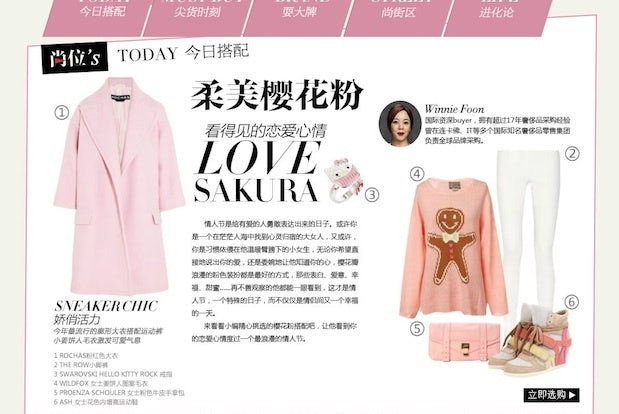
A Valentine's Day ad on Chinese luxury shopping site ShangPin. (ShangPin)
Consumers in the United States, Europe, and Japan typically use credit cards to pay for their online purchases, but in China, the payment preference landscape for e-commerce is dramatically different—which has major implications for China’s luxury e-commerce market.
In addition to credit cards and debit cards, third-party online payment tools and cash-on-delivery (COD) are commonly adopted methods. For luxury brands, these payment tools play a strategic role in building consumer trust, as both payment forms mitigate luxury consumers’ concerns about counterfeit products. Additionally, luxury brands can leverage COD to deliver a unique shopping experience, which in turn will extend the brand’s value proposition and quality.
According to the latest statistics from China Internet Network Information Center, while 63 percent of Chinese online shoppers used credit cards or debit cards to pay for their online purchases, third-party online payment was just as popular, used by 62 percent of online shoppers for their purchases. In addition, 32 percent of these online consumers also chose COD as one of their online shopping payment methods.
So, why is third-party payment so important for Chinese consumers? The answer lies in the fundamental demand of Chinese consumers: safety guaranteed. Online shopping safety is key for e-commerce development in China, and third-party payment emerged to solve this problem.
Take Alipay, for instance. It was first developed by Alibaba to protect its Taobao consumers and mitigate their concerns about online shopping fraud, since at Taobao’s early stage, poor quality products were widespread on its platform. The way Alipay works is partly similar to PayPal in the United States: after an online shopper confirms payment for an order via Alipay, the money will be held by Alipay and not transferred into the seller’s account until the consumer informs Alipay to release the payment. This method helps guarantee that a customer will only have to pay for the product when he or she has received it and feels satisfied with it. In other words, consumers can cancel payment if the purchases do not go as planned.
Alipay will then return the money back into consumers’ accounts if the cancelation application is reasonable or based on the agreement reached by the buyers and sellers. In this way, third-party payment services provide Chinese consumers with a perfect solution for online shopping safety, both for consumers and sellers, which has led to its rapid adoption across China.
Leveraging COD to build trust with Chinese consumers#
Likewise, COD is not a commonly adopted payment method among online consumers in Western markets, yet it is a popular payment method in China. Even though statistics reveal that the popularity of COD is decreasing, nearly one third of Chinese online consumers chose COD as one of their online shopping payment methods. It is a “must-have” payment option provided by most of China’s mainstream B2C e-tailers, such as Jingdong, Amazon China, and Dangdang.
Similar to third-party online payments, COD is another effective solution which lets online consumers feel more secure and comfortable, making their purchase decisions easier and faster. Many Chinese consumers who are new to online shopping usually have the following concerns:
1. Descriptions online do not accurately reflect the actual products they receive
2. Online payment safety
3. Do not know how to use online banking
4. Do not feel comfortable paying without seeing the actual products or knowing a brand
In these cases, providing the payment option of COD is an effective way to increase online store credibility for new customers and improve customer experience for those who are not experts in using online payment methods. Therefore, it can be a determinant factor in online consumers purchasing decisions.
Implications for luxury brands#
When it comes to purchasing luxury or big-ticket product online, Chinese consumers’ concerns about online shopping safety and product authenticity are even greater given the fact that both authorized distributors exist alongside counterfeit luxury good producers.
In the current environment, third-party payment tools and COD play a strategic role in building connections of trust between Chinese consumers and brands for several reasons.
As discussed earlier, third-party payment tools and COD mitigate luxury consumers’ concerns about receiving counterfeit products. Moreover, luxury brands can leverage COD to deliver a unique shopping experience, which in turn will extend the brand’s value proposition and quality. For example, a brand could deliver multiple options (e.g. different sizes or different styles) for a product at once and allow the consumer to choose which product they prefer at their doorstep.
When selling luxury goods in China, businesses should clearly offer credit card and debit card payment options as they would in any Western market. However, it is also important that they do not neglect a substantial population of Chinese e-luxury consumers who would also prefer third-party payment and COD to guarantee the products they receive meet their original expectations for quality and authenticity.
Julia Q. Zhu is the founder of Observer Solutions, a China-focused e-commerce consulting and research firm. Julia formerly worked for Alibaba Group and iResearch in China. Reach her via Twitter or LinkedIn.